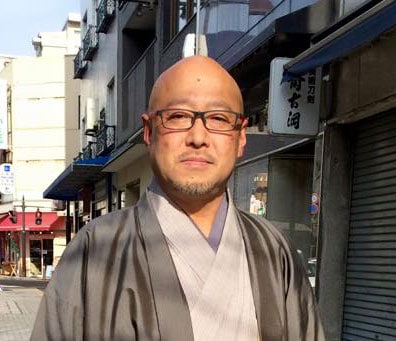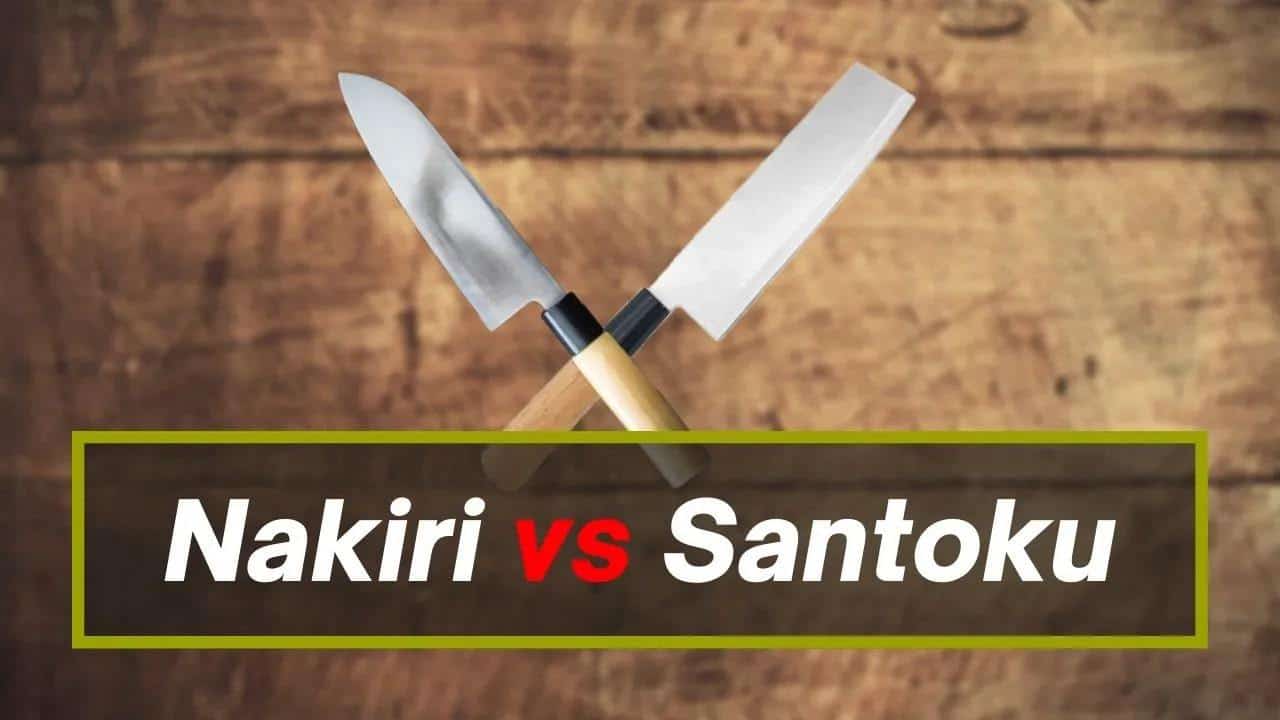Nakiri vs Santoku – The choice here is between a specialized vegetable chopper and an all-purposes slicer. So it’s totally up to you.
Whether you’re hunting for your first knife, or you need to extend your collection with a new one, santoku and nakiri are smart choices. Yet, no knife fits every situation.
As a knife nerd, I’ll show you which one of them is tailored for your needs. Let the knife hunting begin!
NB. Check our Nakiri knife review .
Difference Between the Nakiri and Santoku Knives: At a glance
| Nakiri | Santoku |
| Longer flat area | Shorter flat with a belly |
| 5- 7 inches blade length. | 6.5-7 inches. |
| Larger profile | Smaller profile |
| Rounded tip | Pointed tip |
| Chopper | slicer |
| Double-bevel | Double-bevel (mostly) or single-bevel |
| For chopping vegetables and fruits (specialized) | For cutting meat, vegetables, fish, and cheese. (all-rounder) |
| Touch heavier | Slightly lighter |
Uses
Nakiri is designed for prepping heavy-vegetables meals, while santoku is a multifunctional tool that can handle almost all kitchen tasks.
Choose a Nakiri in these cases:
- If you have a plant-based lifestyle or you cut veggies every day.
- If you cook Asian food ( rarely involves herbs)
- You’re a prep cook who spends long hours with vegetables daily.
- If you own a general-purpose knife like a chef knife or a gyuto and aim to extend your lineup.
If you need more details, check my article about “Should I buy a nakiri knife?“.
Choose a Santoku if:
- You need a small all-rounder knife that fits kitchens with minimal spaces and smaller hands.
- You don’t generally deal with longer stuff like slicing roasts or pumpkin.
- If you cook Mediterranean foods with more herbs and meat incidence.
Now we’re going to compare them in a more detailed way.
Background
In Japanese, nakiri means “ A knife for cutting greens”. It’s the specialized Japanese chopping machine for slicing, dicing, and julienning small and delicate vegetables. You can find it in almost every Japanese house.
Like the nakiri knife, the santoku knife is tailored for home users. “Santoku” translates to “ 3 purposes”. Meaning that it’s an all-rounder which can cut vegetables, fish, and meat. It’s more popular than the nakiri between western chefs.
Profile
The santoku blade is a compromise between the Japanese vegetable cleaver and the western chef’s knife. So, both Japanese knives have a relatively similar shape. Yet, they have many differences that define their particular function.
Nakiri knife

Nakiri vegetable knife is a chopping beast. Every detail in it serves this glorified purpose.
It features a rectangular flat blade with a straight edge and a rounded tip. This will cause complete contact between the stuff and the knife. A Flatter spot means cleaner cuts. No more accordion cuts when slicing peppers.
The flat blade comes generally at 5-7 inches which is handy to cut long vegetables.
More than that, nakiri knives sport a thin blade grounded on both sides (double-bevel). This will ensure you get smooth even slices with keeping the plant fibers intact. Worry not about wedging and steering issues.
The nakiri comes with a relative heft towards the blade. That means the knife will do almost all the work on the behalf of you.
Santoku Knife

Moving along to the Santoku knife, it has a more compact design. It’s generally a smaller stance with a 6.5-7 inches blade length. So santoku is a tad easier to control especially for ladies or people with small hands.
Like the nakiri knife, it’s a thin blade and a narrow spine. However, the santoku knife comes with a pointed tip and a curved blade.
The santoku blade is akin to the western chef’s knife and the gyuto knife. Yet, it’s shorter with less belly to be more convenient for home cooks. IMHO, this modification was at the expense of the performance. For example, you can’t slice a turkey with this short guy.
Santoku knives have commonly double-bevel, but you can also find single-bevel versions.
Performance
Here we come to the meat of the matter. Both knives cut in a very different way.
The wonderful nakiri has a longer flat spot with extra blade weight. That simply means it will give you cleaner, quicker, and effortless cuts compared to the do-all santoku.
Technique
You can use your nakiri in two main ways, the tap chopping motion and the push-cutting technique.

Theoretically, you can cut with a santoku knife in three ways, push-cutting technique, rocking motion as well as the up-and-down way. In the real world, it only excels as a slicer with the forward-and-down type (push-cutting).
Tip or no tip
Needless to say, every cook needs a pointed tip. Yet, when you think about it, you’ll find that most tip work is all about making pretty things for garnishes. Mincing small veggies like shallots is the task that matters.
In that respect, the santoku is better than the nakiri. However, the santoku tip is too low compared to the gyuto or the traditional chef knife which in turn means it won’t rock well.
It’s worth mentioning that you can overcome this issue in the nakiri by modifying your technique. You can use Macro Pierre White method to finely chop onions, as shown on the video, instead of your traditional way.
In short, the nakiri Japenese knife is a great chopper while the small santoku knife with less power is an average slicer.
Benefits of Nakiri
You can see clearly how brilliant the nakiri is when you make a stir-fry meal. You need 4-5 types of veggies plus ginger and garlic cloves. With a nakiri, you’ll QUICKLY chop, dice, and mince every product into FINE UNIFORM cuts. Since the stir-fries need to be cooked fast, this will ensure even cooking to all the ingredients.
Long story short, here’s a summary of the nakiri benefits:
- Full thin slices with the same shape and size.
- Kind for delicate vegetables without sticking issues.
- Speedy and effortless chopping.
- Longer flatter area to cut all lengths.
- Wider blade to scrape the stuff from the board to the bowl (use the spine only).
Benefits of Santoku
Santoku can handle all tasks reasonably well. Yet, it couldn’t trump the performance of a specialized one.
Here’s what makes santoku special:
- Versatile for slicing fish, meats, and greens.
- Easy to maneuver.
- Can be used for detailed tip-work.
Sharpness
Both of them are sharpened to a total of 20-30 degrees. That means every side needs 10-15 degrees.
Nakiri Vs Santoku: Who’s the winner?
Both knives are great choices. Yet it all comes down to your preference and your needs.
Pick up a santoku if that’s your first knife and you need only one versatile blade. Or do yourself a favor and get a Gyuto or 10 inches Chef knife for more mileage.
A nakiri is superior in the vegetable scope. You’ll get precise, rapid, effortless cuts. If you love veggies, that’s yours.

My name is Kenzo Kishita. I’m a retired cook and a knife nerd. Now I’m a full-time home cook and a passionate blogger. Here in the blog, I share with you my love for knives and cooking.
